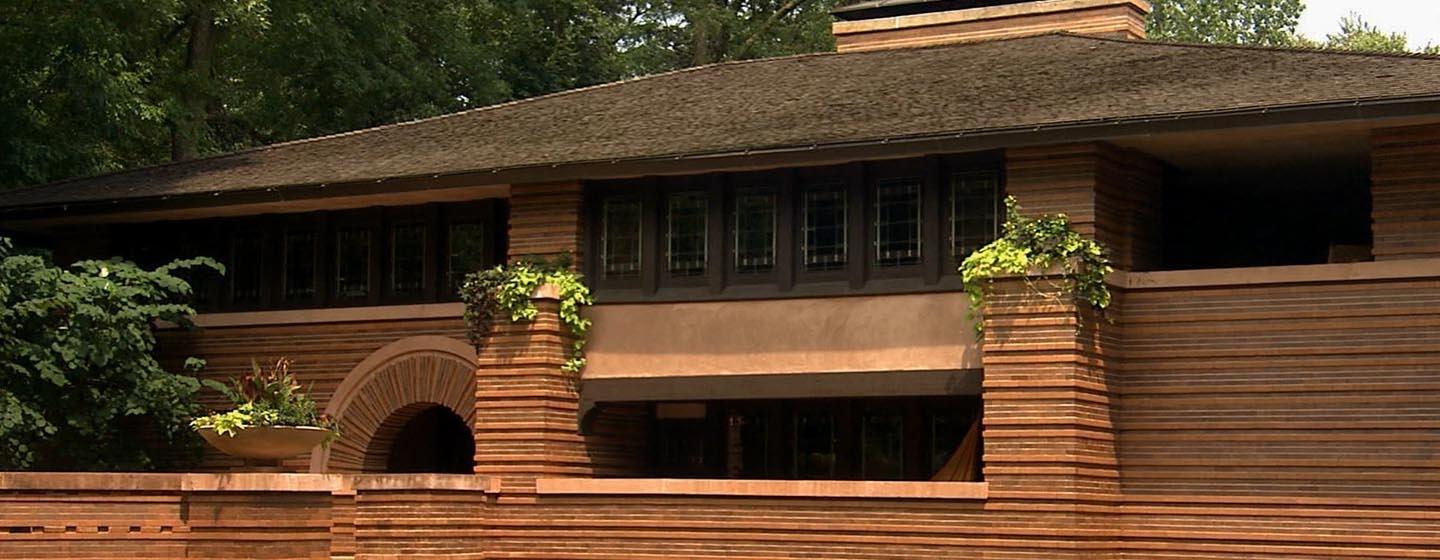
Behind the Scenes: The Making of Frank Lloyd Wright’s Buffalo
by Suzanne Kashuba
“The first question a producer asks is, ‘Where’s the drama?’ ” said WNED PBS Producer Paul Lamont. For his latest project, Frank Lloyd Wright’s Buffalo, which Lamont also wrote and directed, he didn’t have to look far.
In the story of renowned architect Frank Lloyd Wright and the wealthy Buffalo businessman he called his ‘best friend,’ “all elements combined into a producer’s dream,” said Lamont. In their own unique ways, both men led lives of intense struggle and tragedy, as well as great achievement. The story of their 30-year friendship is laden with irony. It’s also the story of ‘the little guy’ who stands behind a famous icon and makes things happen.
The Human Element
Although the program features spectacular cinematography of architectural masterworks, Lamont sought to capture not just the structures, but the compelling human drama that played out within them. “From day one,” Lamont saw that the project had “the potential to transcend architecture. It’s a compelling story when you look at the human element,” he said. “It’s the perfect convergence of characters and events.”
To tell that story, Lamont and his team focused on the universal themes of home, family and friendship. “It’s a story people can relate to on so many levels,” he said. “I want viewers to walk away feeling something, to see not just bricks and windows, but to have an emotional attachment to the buildings and to Martin and Wright,” he said. Then, when people visit the Martin House, “they don’t just see the architecture but the presence of Martin and Wright within the walls and the spaces. They understand why the Martin estate is (designed) the way that it is.”
The Process
Lamont describes his creative process as “organic” and “amorphous.” Initially, there’s no plan or precognition. It begins with a search for a story line and themes, “the right angle.” Then, people who can address those themes are identified and interviewed.
For Frank Lloyd Wright’s Buffalo, interviewing began more than two years before the show would air (in February 2004) with noted Wright scholar Robert McCarter. “They (the interviewees) tell you the story, interpret events, and put the story in context. They convey not facts but the reasons why.” Through letters preserved for the future, the historic characters of Wright and Martin lent their own voices and context to the story.
Related visuals are not used literally (as in a news broadcast) but metaphorically and symbolically or transitionally to depict or convey concepts. The idea of rebirth, for example, was depicted in an image of flowering blooms.
Through an extensive editing process, a voluminous collection of images and interviews are “stripped to the essence” of, and shaped into, the story. More than 50 hours of tape was shot for the one-hour Wright program.
Script writing doesn’t begin until the bulk of the shooting is done. (Frank Lloyd Wright’s Buffalo was 70 percent shot before the initial script was written.) Once scripted, numerous revisions follow. (Wright’s sequence of scripts fills seven 3-inch binders.)
A Guiding Quest
In conveying the Martin-Wright story, the number one question Lamont sought to answer was: Why would Darwin Martin continue to support Frank Lloyd Wright, both financially and emotionally?
“I scoured through hundreds of letters seeking the essence of their connection,” he said. The “goosebump moment” occurred when he read one of Martin’s letters to Wright, through which he encouraged the architect to move forward, despite financial woes and a lack of popular acceptance of his work. He assured Wright that one day he would achieve commercial, as well as artistic, success. And when that happens, Martin told his friend, “there’ll be no losses to count.”
“He saw the genius of the artist,” Lamont concludes. “He saw the guy and his work was good despite his human foibles. He did it for art’s sake.”
Just as Martin gave Wright the freedom to realize his artistic vision in the Martin House, Lamont said he was given the creative freedom to tell their story “the way it needed to be told. I was grateful to pursue the vision I had,” he said. “PBS does allow you that freedom.”